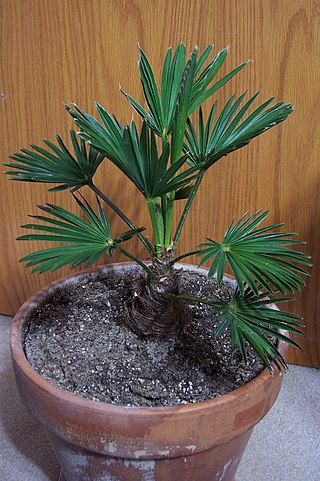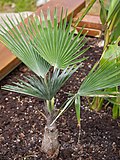
The Arecaceae is a family of perennial, flowering plants in the monocot order Arecales. Their growth form can be climbers, shrubs, tree-like and stemless plants, all commonly known as palms. Those having a tree-like form are colloquially called palm trees. Currently, 181 genera with around 2,600 species are known, most of which are restricted to tropical and subtropical climates. Most palms are distinguished by their large, compound, evergreen leaves, known as fronds, arranged at the top of an unbranched stem, except for the Hyphaene genus, who has branched palms. However, palms exhibit an enormous diversity in physical characteristics and inhabit nearly every type of habitat within their range, from rainforests to deserts.

Trachycarpus fortunei, known in English as Chusan palm and in American as Chinese windmill palm, is a species of hardy evergreen palm tree in the family Arecaceae, native to parts of China, Japan, Myanmar and India.

Sabal minor, commonly known as the dwarf palmetto, is a small species of palm. It is native to the deep southeastern and south-central United States and northeastern Mexico. It is naturally found in a diversity of habitats, including maritime forests, swamps, floodplains, and occasionally on drier sites. It is often found growing in calcareous marl soil. Sabal minor is one of the most frost and cold tolerant among North American palms.

Corypha or the gebang palm, buri palm or talipot palm is a genus of palms, native to India, Malaysia, Indonesia, the Philippines, New Guinea and northeastern Australia. They are fan palms, and the leaves have a long petiole terminating in a rounded fan of numerous leaflets.

Chamaerops is a genus of flowering plants in the family Arecaceae. It contains only one species, Chamaerops humilis, variously called European fan palm or the Mediterranean dwarf palm. It is one of the most cold-hardy palms and is used in landscaping in temperate climates.

Roystonea is a genus of eleven species of monoecious palms, native to the Neotropics, in the Caribbean, the adjacent coasts of Florida in the United States, Mexico, Central America and northern South America. Commonly known as the royal palms, the genus was named after Roy Stone, a U.S. Army engineer. It contains some of the most recognizable and commonly cultivated palms of tropical and subtropical regions.

Trachycarpus takil, the Kumaon palm, is a fan palm tree that is endemic to the foothills of the Himalaya in southern Asia. It is very similar to Trachycarpus fortunei, the windmill palm.

Trachycarpus fortunei 'Wagnerianus' is unknown in the wild, but may have originated in cultivation in Japan, where it was first discovered by the horticulturalist Albert Wagner of Leipzig, Germany in the second half of the 19th century. Wagner made several collecting trips to Japan and China in the 3rd quarter of the 19th century He had a flourishing business growing palms in his steam-heated greenhouses in northern Germany. It has remained in comparative obscurity until recently, when its qualities as a garden plant were at last realized.

Sabal bermudana, commonly known as the Bermuda palmetto or bibby-tree, is one of 15 species of palm trees in the genus Sabal and is endemic to Bermuda although reportedly naturalized in the Leeward Islands. It was greatly affected by the introduction of non-native plants such as the Chinese fan palm, which created competition for space that it usually lost.

Trachycarpus martianus is a tree in the family Arecaceae. There are two distinct populations: one at 1,500 m (5,000 ft) in the Khasia Hills of Meghalaya state, in northeast India, the other at 2,400 m (8,000 ft) in central northern Nepal. Other populations have been reported in Assam, Sikkim, Burma and southern China. The main identifying characteristics are the regular leaf splits, the coffee bean shaped seeds and the bare, as opposed to fibrous trunk. The new leaf spear and edges of the petioles are covered with a white tomentum.

Roystonea regia, commonly known as the royal palm, Cuban royal palm, or Florida royal palm, is a species of palm native to Mexico, the Caribbean, Florida, and parts of Central America. A large and attractive palm, it has been planted throughout the tropics and subtropics as an ornamental tree. Although it is sometimes called R. elata, the conserved name R. regia is now the correct name for the species. The royal palm reaches heights from 15–24 m (50–80 ft) tall. Populations in Cuba and Florida were long seen as separate species, but are now considered a single species.

Trachycarpus princeps is a species of palm endemic to Yunnan in southern central China. It grows on limestone cliffs and ridge tops in monsoonal rain forest in the Salween River valley at elevations of 1,500–1,900 metres (4,900–6,200 ft). The epithet is Latin for "prince" and alludes to "the stately bearing of this palm and the majestic way it looks down from its lofty position on the sheer cliff faces". The species was described in 1995 by Gibbons, Spanner & Chen.
Roystonea princeps, commonly known as Morass cabbage palm or Morass royal palm, is a species of palm which is endemic to western Jamaica.

The Coryphoideae is one of five subfamilies in the palm family, Arecaceae. It contains all of the genera with palmate leaves, excepting Mauritia, Mauritiella and Lepidocaryum, all of subfamily Calamoideae, tribe Lepidocaryeae, subtribe Mauritiinae. However, all Coryphoid palm leaves have induplicate (V-shaped) leaf folds, while Calamoid palms have reduplicate leaf folds. Pinnate leaves do occur in Coryphoideae, in Phoenix, Arenga, Wallichia and bipinnate in Caryota.

Butia yatay, the jelly palm or yatay palm, is a Butia palm native to southern Brazil, Uruguay and northern Argentina. It is known as the butiá-jataí in Portuguese in the south of Brazil, as well as simply jataí or butiá. It is sometimes cultivated as an ornamental in Europe and the United States. It is the tallest of all the species in the genus Butia. The fruit is edible with a sweet flavour.
Trachycarpus oreophilus, also known as Thai mountain fan palm, is a plant species in the genus Trachycarpus. It is known from two distinct populations, one in northwest Thailand, the other in Manipur in northeastern India. The Manipur population was formerly considered a separate species.

Borasseae is a tribe in the palm subfamily Coryphoideae. The tribe ranges from southern Africa and Madagascar north through the Arabian Peninsula to India, Indochina, Indonesia and New Guinea. Several genera are restricted to islands in the Indian Ocean. The two largest genera, Hyphaene and Borassus, are also the most widespread.

Chuniophoeniceae is a tribe of palms in subfamily Coryphoideae of plant family Arecaceae. The four genera within the tribe are morphologically dissimilar and do not have overlapping distributions. Three of the genera are monotypic, while the fourth genus (Chuniophoenix) has three species.

Trachycarpeae is a tribe of palms in subfamily Coryphoideae of the plant family Arecaceae. It has the widest distribution of any tribe in Coryphoideae and is found on all continents, though the greatest concentration of species is in Southeast Asia. Trachycarpeae includes palms from both tropical and subtropical zones; the northernmost naturally-occurring palm is a member of this tribe. Several genera can be found in cultivation in temperate areas, for example species of Trachycarpus, Chamaerops, Rhapidophyllum and Washingtonia.

























